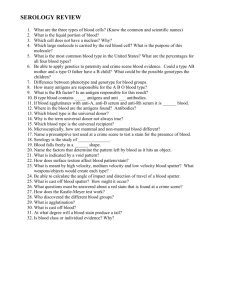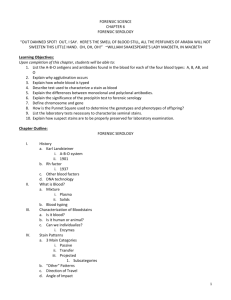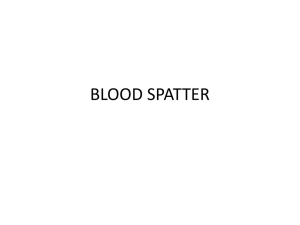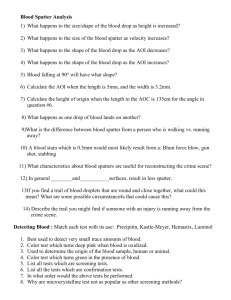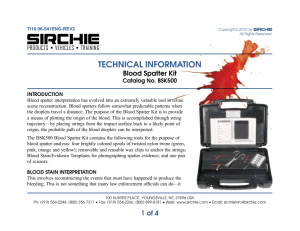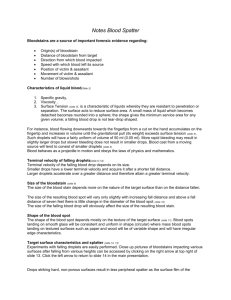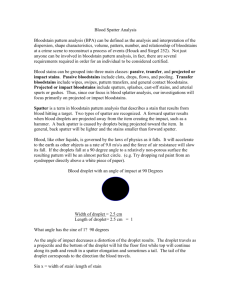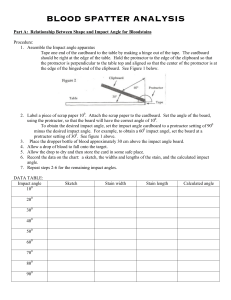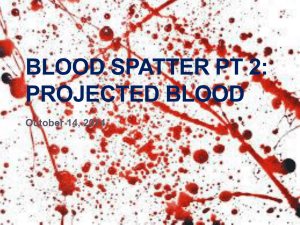Blood spatter analysis File
advertisement
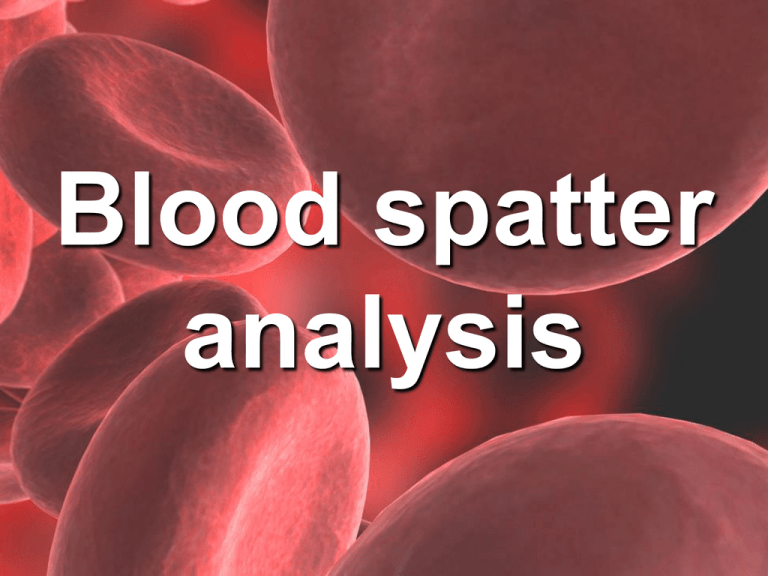
Blood spatter analysis An adult human contains about 5 litres of blood. Loss of approx 30% blood volume (1.5 litres) through either internal or external bleeding usually results in a person losing consciousness. The loss of 40% (2 litres) blood volume can be fatal. What can forensics do? Forensic scientists can reconstruct events at crime scenes from the blood spatter patterns present. They can determine from a blood stain… • Direction of travel • Angel of impact • Nature of the force • Relative positions of individuals at a scene • The sequence of events that may have occurred 3 velocities of blood spatter • High velocity blood spatter may have come from a gunshot wound inflicted by a bullet moving at 900 feet/second. • Medium velocity may have resulted from a spurting artery or a blunt instrument striking the already bloody head or limb of a victim. • Low velocity blood may have dripped from a wound or blood-soaked item. High velocity blood spatter • High velocity blood spatter is produced by an external force greater than 100 feet/sec. • The stains, sometimes referred to as a mist, tend to be less than 1mm. • Usually created by gunshots or explosives, high velocity patterns also may result from industrial machinery or even expired air, such as coughing or sneezing. • High velocity droplets travel the shortest distance because of the resistance of the air against their small mass. Medium velocity blood spatter • An external force of greater than 5 feet/sec but less than 25 feet/sec causes medium blood spatter. • The stains generally measure 1 to 3 mm. • Most medium velocity stains found at crime and accident scenes form patterns created by blood flying from a body to a surface as a result of blunt or sharp trauma or the body colliding with rounded or edged surfaces. • It may result from a punch, stabbing, or a series of blows or, in the case of an accident, the body striking surfaces inside or outside a vehicle. Low velocity blood spatter • Low velocity blood spatter is created by an external force less than 5 feet/sec (normal gravity) • The stains are generally 3 mm and larger. • It usually results from blood dripping from a person walking or running or from a bloody weapon. • Dripping blood often falls at a 90-degree angle and forms a 360-degree (circular) stain when it hits a flat surface. The longer the blood stain the lower the angle of impact Spatter diameter increases with height + spikes appear at edge of stain Direction of blood The stringing method Used to determine point of convergence of several blood spatter stains (i.e. location of the victim) After measuring the width & length of the blood spatter a simple calculation can be done to determine the angle of impact. Area of convergence (2D origin of spatter) Angle of impact Example What to record: - Length & width of each blood drop - Distance to point of origin from the back of each blood drop Point of Origin of Spatter (3D) 2 methods to calculate point of origin (3D) Both methods need these initial steps at the crime scene:1. Identify stains that have a common area of convergence 2. Draw lines along the central axis of each stain to determine location of convergence 3. Measure the distance from the back edge of the stain to the area of convergence 4. Calculate the angle of impact for each stain individually 5. Ensure at least 3 stains are used (the more the better) Method 1 - graphing 1. X-axis represents the location of the blood stain (eg. floor) 2. Z-axis represents the height from the stain 3. Both axes must be drawn using the same scale 4. Mark on the x-axis the distance to the point of convergence for each individual stain 5. Use a protractor to draw a line at the angle of impact from the mark on the x-axis until it touches the z-axis 6. The area on the z-axis that the lines converge will be the likely point of origin Distance to PoC Angle of impact Stain 1 8cm 68o Stain 2 16cm 52o Stain 3 23cm 41o Method 2 - Trig Example: If D = 30cm & H = tan35 x 30 H = 21cm i = 35o Now its your turn! 1. Draw lines of convergence 2. Work out the angle of impacts for all 3 blood stains 3. Work out the point of origin for the 3 blood stains using:a) Graphing b) Trig c) Triangulation (strings)
